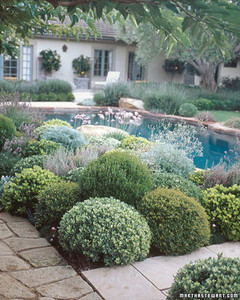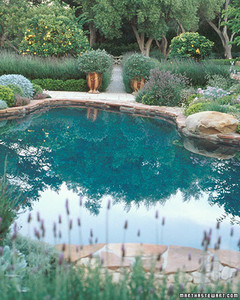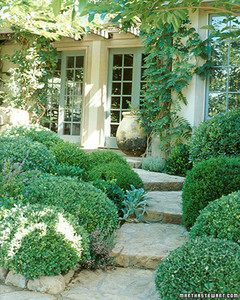



Although laying out a garden is never simple, you can get started on the right track by asking yourself five key questions and following the basic principles of good design. Whether you're creating a romantic cottage garden or a formal landscape, begin with practical considerations.
Before buying plants or tilling any ground, answer the following questions:
1. What are your needs and priorities?Do you want a spot for vegetables or only colorful flowers? Do you need a separate play space for kids, or can you combine it with an area for entertaining?
2. What is the style of your house?Classic or modern? Brick or stucco? Use these cues as the starting points for your design.
3. What is the existing structure of your garden? Do you have specimen trees, mature hedges, and stone walls worth saving or features like overgrown foundation plantings or dying trees that must be removed?
4. What kind of light does each area of your garden receive? Observe how the light moves across your property during various seasons, noting shady areas and open, sunny patches.
5. What is your budget? Consider spreading expenses over several seasons, and prioritize accordingly. Although some construction projects can be postponed and phased in, sprinklers that require trenching, for instance, can't wait. Larger trees and hedges need early attention, too.
A well-designed garden should link the house to the yard both physically and visually, affecting the entire living space: Interiors that open onto terraces and views feel expansive, while gardens that fold into living areas impart intimacy. Consider the prevailing spirit of the landscape -- thinking about your region, neighborhood, and house -- then choose and place plants and structures accordingly.
-Make the garden accessible by creating a physical connection, such as French doors, from rooms to outdoor areas. For example, consider designing a dining terrace close to the kitchen.
-Plot patios and walks, taking cues from your home's style and materials. Take stock of the view from each window to determine sight lines that will organize your landscape. Place a path where your eye naturally moves through the lot. Lay paths that crisscross to carve the garden into different planting areas.
-Use benches or urns as focal points in natural resting places -- under shady trees or at the intersections of paths.
-If you don't already have sizable shrubs or trees along your property line, invest in fast-growing plants, which can help block unappealing views. To create the illusion of a single expansive space and to screen out neighbors' houses, note choice trees within view, and plant the same kinds of trees on your own land.
Variety enlivens a garden. Consider creating a number of small, intimate spaces that lead from one to another, anchored by a focal point such as an urn or a bubbling fountain, which will muffle road sounds.
To start, assess the existing garden structure:
-Make scale drawings or take panoramic photographs of the landscape, then sketch in possible changes on overlays of tracing paper. Sketching proposed layouts and features will help you envision your options; it will also ensure that additions are in scale with existing elements.
-Look for existing noteworthy elements, such as specimen trees, mature hedges, and stone walls, which can give a new garden instant character. (But don't hesitate to remove features you'd rather live without, such as overgrown foundation shrubs that block windows.)
Then, implement your garden design:
-Separate areas from one another by planting hedges and shrub borders. Install arbors, trellises, or other structures for climbing vines, which will shelter seating areas and create intimacy.
-Raise or lower parts of the terrain by hauling in or scooping out dirt. While a small, flat lot reveals its secrets all at once, a graded landscape fools the eye into believing the garden is larger.
-Make the outdoors a place to explore: Build steps that follow a slope and paths that curve out of sight, or hide a bubbling fountain; the sound of water will compel visitors to seek its source.
Once your garden design -- terrace paving, paths, trees, arbors, and hedges -- is clearly drawn, compose a plant palette. Go beyond choosing plants that harmonize with your home (like pairing old-fashioned hollyhocks with a shingled saltbox).
-Consider what thrives in your neighbors' yards and suits the locale, whether native plants or transplants from similar conditions. Consider rainfall and seasonal temperatures as well as coastal and inland influences.
-Consult books and your local nursery to find out the requirements for the plants you like and how large they will grow.
-Decide how much maintenance you're willing to commit to: Do you welcome challenges, or do you need tough, self-sufficient plants?
-Think about whether the emphasis will be on foliage textures, flowers, or both. Do you want seasonal change or year-round, evergreen fullness?
-Buy small: As a rule, younger plants tend to acclimate better to new settings.
-Group plants with similar irrigation needs as well as harmonious colors and textures. Save exotic, finicky ones for pots, where they can get individual attention.
-Be bold: Create a strong, unified effect by planting in drifts of one or two kinds of plants rather than mixing many different types in one area.
Original article and pictures take http://www.marthastewart.com/264129/garden-design-101 site
Комментариев нет:
Отправить комментарий